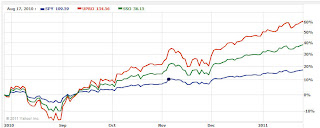The traditional strategy for index funds is simply to buy and hold, reinvesting all dividends. My concern is that such an approach is a roller coaster where you are 100% at risk 100% of the time and there is no opportunity to recognize gains.
I’d like to try and leverage my existing trading strategy and utilize one or more index funds (ETFs). I want to continue to maintain and pool of funds that will allow me to buy in incrementally when the price is low, but still maximize realized gain and minimize risk by holding cash whenever practical.
I’ve established a pool of rules/triggers below that I think will yield the desired results. I will next test these triggers using historical date ranges of known bear, bull and stagnant markets. After reviewing results, I’ll modify the triggers accordingly.
Initial Set up:
First determine the funds that you have set aside for this purpose. For purposes of this exercise, I’ll assume $200,000 as this is sufficient for buying round lots, but is also not enough to allow for an extreme number of buy-ins. The initial buy-in should be 20% of the available funds at the current market price. Of course, you can wait for a dip, but there’s a chance that the dip will never come and you’ve lost an opportunity, so I’d recommend immediate buy-in.
Triggers:
There are several items that are considered for the triggers. Current percent invested level, what was the last transaction (buy or sell), last transaction price, number of consecutive buys/sales.
Buys triggers would be set whenever the price drops from the last transaction. If the previous transaction was a sale, then the new buy price should be 5% less than the last sale price. If the last transaction was a buy, then the buy price drops by 1% for each transaction. So if the initial buy in is $100 (100%), then the second buy in is at $99 (99% or $100), the third is $97.02 (98% or $99), the fourth is $94.11 (97% or 97.03).
Buy amounts will be 20% or the total funds until the percentage invested is over 50%. After that, buy-ins are 10% of total funds up to 90%. After 90% invested, further buy-in should be done at your own discretion.
Sell triggers will increment at 6%. However, the sell trigger should be based on the average buy-in price, not the last buy-in price. If there are multiple consecutive sales and the average price is 100, then the first sell price is $106, the second is $112 and the third is $118. If the last transaction was a buy, then the sale price reverts back to 106%.
Sale amounts will 30% of the held shares for the first two consecutive sales and 10% of held shares for subsequent sales.
Next step is to test and refine the strategy. I’ve targeted the following date ranges for testing and will use the SPY ETF:
- 3/1/2007-3/1/2008 for bull market
- 3/1/2008-3/1/2009 for bear market
- 3/1/2010-3/1/2011 for stagnant market















